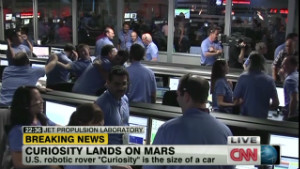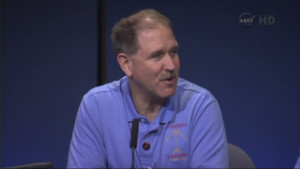火星车成功登陆-NASA's rover Curiosity lands on Mars
来源:互联网 发布:淘宝知识产权投诉 编辑:程序博客网 时间:2024/05/01 01:54

'Curiosity' sends out first Mars photo - 从火星发来的第一张照片
(CNN) -- NASA's rover Curiosity successfully carried out a highly challenging landing on Mars early Monday, transmitting images back to Earth after traveling hundreds of millions of miles through space in order to explore the Red Planet.
周一早晨(北京时间13:30)美国国家航天局的“好奇”号火星车成功完成了高挑战性的着陆任务,为了探索火星这颗红色星球,飞船在太空中旅行了几亿英里后,终于发回了照片。
The $2.6 billion Curiosity made its dramatic arrival on Martian terrain in a spectacle popularly known as the"seven minutes of terror."
价值26亿美元的“好奇”号在经历了众所周知的“恐怖7分钟”的壮观场景后戏剧性地到达了火星表面。
This jaw-dropping landing process, involving a sky crane and the world's largest supersonic parachute, allowed the spacecraft carrying Curiosity to target the landing area that scientists had meticulously chosen.
这个令人惊讶的着陆过程,应用到了一个空中吊车和地球上最大的超音速降落伞,使得载着“好奇“号的太空船可以着陆到科学家们精心选择的区域。
The mission control in NASA's Jet Propulsion Laboratory in California burst into cheers as the rover touched down. Team members hugged and high-fived one another as Curiosity beamed back the first pictures from the planet, some shed tears.



"The successful landing of Curiosity -- the most sophisticated roving laboratory ever to land on another planet -- marks an unprecedented feat of technology that will stand as a point of national pride far into the future," President Barack Obama said in a statement congratulating the NASA employees who had worked on the project.
The scientific community reacted to the achievement with a mixture of elation and relief.
"Rationally I know it was supposed to work all along, but emotionally it always seemed completely crazy," said James Wray, assistant professor at Georgia Institute of Technology, who is affiliated with the science team of Curiosity. "So to see all those steps being ticked off and actually working, it's a huge relief."
The initial images the SUV-sized rover sent back to Earth were black and white and grainy, but one showed its wheel resting on the stony ground and the vehicle's shadow appeared in another. Larger color images are expected later in the week, NASA said.
The spacecraft had been traveling away from Earth since November 26 on a journey of approximately 352 million miles (567 million kilometers), according to NASA.
Curiosity, which will be controlled from the Jet Propulsion Laboratory, has a full suite of sophisticated tools for exploring Mars. They include 17 cameras, a laser that can survey the composition of rocks from a distance and instruments that can analyze samples from soil or rocks.
The aim of its work is "to assess whether Mars ever had an environment able to support small life forms," NASA says.
Meet a rover driver: His car is on Mars
Curiosity's first stop is Gale Crater, which may have once contained a lake. After at least a year, the rover will arrive at Mount Sharp, in the center of the crater. The rover will drive up the mountain examining layers of sediment. This process is like looking at a historical record because each layer represents an era of the planet's history, scientists say.
The phenomenon of sedimentary layers is remarkably similar to what is seen on Earth, in California's Death Valley or in Montana's Glacier National Park, says John Grotzinger, chief scientist of theMars Science Laboratory mission.
Rocks and minerals found on Earth are different than on Mars, but the idea of a mountain made of layers is familiar to scientists. Unlike on Earth, however, Mars has no plate tectonics, so the Martian layers are flat and not disrupted as they would be on Earth. That also means that Mount Sharp was formed in a different way than how mountains are created on Earth -- no one knows how.
Images: Exploring Mars
In these layers, scientists are looking for organic molecules, which are necessary to create life. But even if Curiosity finds them, that's not proof that life existed -- after all, these molecules are found in bus exhaust and meteorites, too, says Steve Squyres, part of the Mars Science Laboratory science team.
If there aren't any organics, that may suggest there's something on the planet destroying these molecules, said Wray, of Georgia Tech. But if Curiosity detects them, Wray said, that might help scientists move from asking, "Was Mars ever habitable?" to "Did Mars actually host life?"
Curiosity's mission is also significant in an era when NASA's budgets are shrinking and China is becoming more ambitious in its space exploration program.
"I feel like it's a signal that we have the capability to do big and exciting things in the future." said Carol Paty, assistant professor at Georgia Tech's School of Earth and Atmospheric Sciences. "You can't not be excited."
Liquid water is not something scientists expect to be apparent on Mars because the planet is so cold and dry, Squyres said. If the planet does harbor liquid water today, it would have to be deep below the surface, perhaps peeking out in a few special places, but not likely to be seen by Curiosity, Squyres said.
Rover to search for clues to life on Mars
It's hard to know how long ago liquid water would have been there because there's no mechanism to date the rocks that rovers find on Mars, Squyres said.
Evidence from the spacecraft NASA has sent to Mars so far suggests that the "warm and wet" period on Mars lasted for the first billion years of the planet's history.
"In order to create life, you need both the right environmental conditions -- which includes liquid water -- and you need the building blocks from which life is built, which includes organics," Squyres said. The Mars Science Laboratory is a precursor mission to sharper technology that could do life detection, Grotzinger said.
There aren't specific molecules that scientists are looking for with Curiosity. The attitude is: "Let's go to an interesting place with good tools and find out what's there," Squyres said.
What do you think about the Mars mission? Go to iReport
Curiosity is supposed to last for two years on Mars, but it may operate longer -- after all, Spirit and Opportunity, which arrived on Mars in 2004, were each only supposed to last 90 Martian days. Spirit stopped communicating with NASA in 2010 after getting stuck in sand, and Opportunity is still going.
"You take what Mars gives you," said Squyres, also the lead scientist on the Mars Exploration Rover Mission, which includes Spirit and Opportunity. "If we knew what we were going to find, it wouldn't be this much fun."
- 火星车成功登陆-NASA's rover Curiosity lands on Mars
- NASA:我们不够钱登陆火星
- NASA好奇号火星车安度 WindRiverVxWorks再建奇功
- 臭名昭著的Bug们之三:NASA火星极地登陆器
- NASA研发首架登陆火星的人造飞行器,高效翼型飞翼实验-(普朗特-D3)试飞。
- 火星移民(mars)
- NASA 讨论在火星部署磁场
- Apache Cordova development lands on Visual Studio Code
- 49 U.S. Scientists Confirm Water on Mars
- GOOGLE登陆火星
- Google “登陆”火星
- 好奇号登陆火星
- hdu Invade the Mars(侵入火星)
- NASA 下一次火星探测高峰已经准备就绪
- NASA洞察号探测器明年将洞察火星内部
- 载人火星计划演化《火星救援》:登陆火星为何难
- The Boss on Mars
- NASA
- tcp.c文件的tcp_listen_select函数(14)
- The Two Interceptors: HttpModule and HttpHandlers
- 获取手机系统号码
- OCX--抓图,录音
- 从对象到方面
- 火星车成功登陆-NASA's rover Curiosity lands on Mars
- cocos2d-x学习笔记(5)-- CCScene场景的切换
- 适用建议
- 索引的原理及索引建立的注意事项
- 别人的好的文章地址
- call和apply性能对比
- vs2010中的profile以及调试技巧
- div层次嵌套问题
- java连接C++动态库


